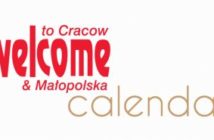![]()
For many years the Renaissance castle in Niepołomice, just outside of Kraków played the role of a summer residence for Polish kings. They went there for the famous forest in which they organized extravagant hunting parties. Today, this beautifully restored building, built on the plan of a quadrangular cloistered courtyard, is the principal calling card of this dynamic town. The museum there displays a collection of hunting and fishing implements, and currently one can see a rather extraordinary exhibit called “I found ancient times to be very pretty. Antiquity through the eye of a collector”.
The exhibit was prepared by the National Museum, which made its own collection available, along with items from the Czartoryski Princes’ Museum, and from the Potocki family’s collection from Krzeszowice and the National Museum in Krakow.
– Dorota Gorzelany, the curator of the exhibit says, “Historical items are distributed through two galleries giving male and female perspectives from both the human world and that of the gods. The world of mythology permeates the temporal world creating a unitary wholeness in the way in which it was perceived in ancient times”.
The ancient world of masculinity is displayed in the first gallery. Here can be found marble copies of bronze Roman statues of the Discophorus and the Doryphoros by Polyclitus, one of the most important Greek sculptors from the Classical Period (5th century BC). These are accompanied by a statue of Mercury, an example of 19th century reconstruction activities, and a sculpture which once was used as a fountain decoration depicting the god of a river and a peasant with an amphora. Items gathered into one display case depict the Egyptian gods Amon, Osiris, and Serapes, as well as mortals in the process of offering sacrifices, standing before the face of the gods and fulfilling their public function. A group of warriors are depicted in Assyrian and Roman reliefs, as well as Greek vases decorated with scenes of battles and a pyrrhic war dance. Both sporting and martial motifs are found in the displayed head of Heracles, the most important of Greek heroes. A second group of objects are more Dionysian.
Depictions of the gods Isis, Aphrodite, and Dianna are displayed in the second gallery of the exhibit, along with portraits of Egyptians, Greeks, Romans, and Etruscans. They represent maternal care, concern for beauty, and the independent aspect of the female spirit. Some of the women hold mirrors or fans; others, a basket, a tambourine or the musical instrument known as a sistrum. These objects indicate an involvement in religious activities. The beauty of a woman was thought to be found in a well cared-for appearance. Cosmetic utensils were made from a variety of materials and were artistically shaped. They were used to prepare and preserve lipsticks or fragrant ointments. These display items are accompanied by jewelry – including some costly items, like gold, and some cheaper items like ceramics. Among them are a delicate bracelet decorated by the Etruscan method of filigree and granulation, as well as a commonly worn necklace made of glass which could also be used as a musical instrument called the menit. The practice of decorating marble statuary with metallic elements is represented in an example of Aphrodite’s head with a golden earring.
![]()
Antyk w Niepołomicach
Renesansowy zamek w podkrakowskich Niepołomicach przez lata odgrywał rolę letniej rezydencji polskich królów. Wyjeżdżali tam dla otaczającej zamek słynnej puszczy, w której urządzali wielkie polowania. Dzisiaj ta przepięknie odrestaurowana, zbudowana na planie czworokąta budowla z krużgankowym dziedzińcem, jest wizytówką tego dynamicznego miasteczka. Znajdujące się tam muzeum prezentuje zbiory myśliwskie i łowieckie. Jednak obecnie zwiedzić można tam wystawę w tym kontekście nieco zaskakującą a nazwaną „Znajduję starożytności bardzo piękne. Antyk okiem kolekcjonera”.
Wystawę przygotowało Muzeum Narodowego, które udostępniło zbiory własne, a także pochodzące z Muzeum Książąt Czartoryskich i z kolekcji Rodziny Potockich z Krzeszowic i Muzeum Narodowego w Krakowie.
Zabytki rozmieszczone w dwóch salach oddają ideę sfery kobiecej i męskiej zarówno w świecie ludzi, jak i bogów. Świat mitologiczny przenika się ze światem doczesnym tworząc spójną całość w sposób, w jaki postrzegano je w starożytności – mówi Dorota Gorzelany, kurator wystawy.
Pierwsza sala pokazuje antyczny świat mężczyzn. Znajdują się tam marmurowe kopie rzymskie brązowych posągów atletów Dyskoforosa i Doryforosa Polikleta, jednego z najważniejszych rzeźbiarzy greckich okresu klasycznego (V wiek p.n.e.). Towarzyszy im rzeźba Merkurego, przykład XIX-wiecznej działalności rekonstrukcyjnej, oraz zdobiący niegdyś fontannę posąg boga rzeki i chłopca z amforką. Zabytki zgrupowane w gablotach pokazują wyobrażenia bogów egipskich – Amona, Ozyrysa, Serapisa – a także śmiertelników podczas składania ofiary, stojących przed obliczem boga i pełniących funkcje publiczne. W grupie wyobrażeń wojowników znajduje się asyryjski i rzymski relief, a także greckie wazy dekorowane scenami walki i tańca wojennego pyrriche. Wątek sportowy i wojenny łączy przedstawienie głowy Heraklesa, najważniejszego herosa greckiego.
W drugiej sali zgromadzono przedstawienia bogiń – Izydy, Afrodyty, Diany oraz portrety Egipcjanek, Greczynek, Rzymianek i Etruski. Prezentują one matczyną opiekę, dbałość o piękno i niezależny aspekt duszy kobiecej. Jedne kobiety trzymają lustro lub wachlarz, inne kosz, tamburyn czy instrument muzyczny sistrum – przedmioty wskazujące na udział w czynnościach kultowych. Piękno kobiety postrzegano jako zadbany wygląd. Przedmioty kosmetyczne wykonywano z różnych materiałów nadając im czasami plastyczną formę. Wykorzystywano je do przygotowywania i przechowywania szminek czy pachnących balsamów. Zabytkom tym towarzyszy biżuteria, zarówno kosztowna – złota, jak i tania – fajansowa. Wśród nich znajduje się bransoleta misternie dekorowana przez rzemieślnika etruskiego metodą filigranu i granulacji oraz powszechnie noszone naszyjniki z masy szklanej, których połączone sznurki tworzyły instrument muzyczny menat. Główka Afrodyty ze złotym kolczykiem jest przykładem zdobienia marmurowych rzeźb elementami metalowymi. (b)
![]()
Das Renaissance-Schloss in dem in der Nähe Krakaus liegenden Niepołomice spielte über Jahre die Rolle einer Sommerresidenz der polnischen Könige. Sie fuhren dorthin wegen des das Schloss umgebenden berühmten Urwaldes, in dem sie große Jagden veranstalteten. Heute ist der herrlich restaurierte, auf einem Viereck errichtete Bau mit einem Kreuzgang-Innenhof eine Visitenkarte dieses dynamischen Städtchens. Das im Schloss eingerichtete Museum präsentiert Jagdsammlungen. Zur Zeit aber kann man dort eine in diesem Kontext überraschende Ausstellung besichtigen, die unter dem Titel „Ich finde sehr schöne Antiken. Das Altertum mit dem Auge des Sammlers“ steht.










